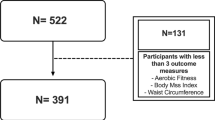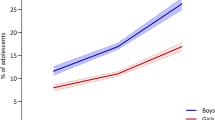Abstract
Objective:
To investigate the relations of attendance of children in an after-school physical activity (PA) program to changes in body composition and cardiovascular fitness (CVF).
Design:
Eight-month after-school PA-based intervention.
Subjects:
In all, 278 third-grade boys and girls from nine elementary schools (age, 8.7 y (s.d.=0.6 y), body mass index (BMI) 19.1 kg/m2 (s.d.=4.4) and percent body fat (%BF) 26.0 (s.d.=9.0)).
Measurements:
Body composition (from dual-energy X-ray absorptiometry), BMI (from height and weight), waist circumference (WC) and CVF (from the YMCA submaximal bench-stepping test).
Results:
There was a significant negative linear trend between level of attendance in the after-school program and change in %BF and fat mass; there was also a significant positive linear trend between program attendance and change in CVF. There was a marginally significant linear trend between program attendance and fat-free mass. Greater increases in bone mineral density were observed with higher program attendance. Changes in BMI and WC were not influenced by program attendance.
Conclusion:
Understanding the dose–response effect of PA on health outcomes, particularly body composition, in children is crucial in our effort to prevent overweight and its health consequences. Since there is limited data available to base PA dose recommendations for youths, findings from this study are relevant, and suggest that greater health benefits can be obtained in young children with more frequent participation in PA.
This is a preview of subscription content, access via your institution
Access options
Subscribe to this journal
Receive 12 print issues and online access
$259.00 per year
only $21.58 per issue
Buy this article
- Purchase on Springer Link
- Instant access to full article PDF
Prices may be subject to local taxes which are calculated during checkout



Similar content being viewed by others
References
Ogden CL, Flegal KM, Carroll MD, Johnson CL . Prevalence and trends in overweight among US children and adolescents, 1999–2000. JAMA 2002; 288: 1728–1732.
Hedley AA, Ogden CL, Johnson CL, Carroll MD, Curtin LR, Flegal KM . Prevalence of overweight and obesity among US children, adolescents, and adults, 1999–2002. JAMA 2004; 291: 2847–2850.
Troiano RP, Flegal KM, Kuczmarski RJ, Campbell SM, Johnson CL . Overweight prevalence and trends for children and adolescents. The National Health and Nutrition Examination Surveys, 1963 to 1991. Arch Pediatr Adolesc Med 1995; 149: 1085–1091.
Cole TJ, Bellizzi MC, Flegal KM, Dietz WH . Establishing a standard definition for child overweight and obesity worldwide: international survey. BMJ 2000; 320: 1240–1245.
Lobstein T, Baur L, Uauy R . Obesity in children and young people: a crisis in public health. Obes Rev 2004; 5 (Suppl 1): 4–104.
Olshansky SJ, Passaro DJ, Hershow RC, Layden J, Carnes BA, Brody J, Hayflick L, Butler RN, Allison DB, Ludwig DS . A potential decline in life expectancy in the United States in the 21st century. N Engl J Med 2005; 352: 1138–1145.
Dietz WH . Health consequences of obesity in youth: childhood predictors of adult disease. Pediatrics 1998; 101: 518–525.
Sorof JM, Lai D, Turner J, Poffenbarger T, Portman RJ . Overweight, ethnicity, and the prevalence of hypertension in school-aged children. Pediatrics 2004; 113: 475–482.
Freedman DS, Dietz WH, Srinivasan SR, Berenson GS . The relation of overweight to cardiovascular risk factors among children and adolescents: The Bogalusa Heart Study. Pediatrics 1999; 103: 1175–1182.
Centers for Disease Control and Prevention (CDC). Physical Activity and Good Nutrition: Essential Elements to Prevent Chronic Diseases and Obesity. US Department of Health and Human Services: Atlanta, GA; 2004.
Eyre H, Kahn R, Robertson RM, Clark NG, Doyle C, Hong Y, Gansler T, Glynn T, Smith RA, Taubert K, Thun MJ . Preventing cancer, cardiovascular disease, and diabetes: a common agenda for the American Cancer Society, the American Diabetes Association, and the American Heart Association. Circulation 2004; 109: 3244–3255.
Thompson PD, Buchner D, Pina IL, Balady GJ, Williams MA, Marcus BH, Berra K, Blair SN, Costa F, Franklin B, Fletcher GF, Gordon NF, Pate RR, Rodriguez BL, Yancey AK, Wenger NK . Exercise and physical activity in the prevention and treatment of atherosclerotic cardiovascular disease: a statement from the Council on Clinical Cardiology (Subcommittee on Exercise, Rehabilitation, and Prevention) and the Council on Nutrition, Physical Activity, and Metabolism (Subcommittee on Physical Activity). Circulation 2003; 107: 3109–3116.
Oja P . Dose response between total volume of physical activity and health and fitness. Med Sci Sports Exerc 2001; 33: S428–S437; discussion S452–S453.
Ross R, Janssen I . Physical activity, total and regional obesity: dose–response considerations. Med Sci Sports Exerc 2001; 33: S521–S527; discussion S528–S529.
Slentz CA, Duscha BD, Johnson JL, Ketchum K, Aiken LB, Samsa GP, Houmard JA, Bales CW, Kraus WE . Effects of the amount of exercise on body weight, body composition, and measures of central obesity: STRRIDE—A Randomized Controlled Study. Arch Intern Med 2004; 164: 31–39.
Vuori I . Dose–response of physical activity and low back pain, osteoarthritis, and osteoporosis. Med Sci Sports Exerc 2001; 33: S551–S586; discussion 609–610.
Després J . Body fat distribution, exercise and nutrition: implications for prevention of atherogenic dyslipidemia, coronary heart disease, and non-insulin dependent diabetes mellitus. In: Lamb D, Murray R, (eds) Prospectives in Exercise Science and Sports Medicine. Cooper Publishing: Carmel; 1998. pp 107–150.
Gutin B, Barbeau P, Yin Z . Exercise interventions for prevention of obesity and related disorders in youths. Quest 2004; 56: 120–141.
Hunter G, Weinsier R, Bamman M, Larson D . A role for high intensity exercise on energy balance and weight control. Int J Obes Relat Metab Disord 1998; 22: 489–493.
Gutin B, Yin Z, Humphries MC, Barbeau P . Relations of moderate and vigorous physical activity to fitness and fatness in adolescents. Am J Clin Nutr 2005; 81: 746–750.
Barbeau P, Gutin B, Litaker M, Owens S, Riggs S, Okuyama T . Correlates of individual differences in body-composition changes resulting from physical training in obese children. Am J Clin Nutr 1999; 69: 705–711.
Kang H, Gutin B, Barbeau P, Owens S, Lemmon C, Allison J, Litaker M, Le N . Physical training improves insulin resistance syndrome markers in obese adolescents. Med Sci Sports Exerc 2002; 34: 1920–1927.
Owens S, Gutin B, Allison J, Riggs S, Ferguson M, Litaker M, Thompson W . Effect of physical training on total and visceral fat in obese children. Med Sci Sports Exerc 1999; 31: 143–148.
Ferguson MA, Gutin B, Owens S, Barbeau P, Tracy RP, Litaker M . Effects of physical training and its cessation on the hemostatic system of obese children. Am J Clin Nutr 1999; 69: 1130–1134.
Gutin B, Barbeau P, Owens S, Lemmon CR, Bauman M, Allison J, Kang H-S, Litaker MS . Effects of exercise intensity on cardiovascular fitness, total body composition, and visceral adiposity of obese adolescents. Am J Clin Nutr 2002; 75: 818–826.
Gutin B, Owens S, Okuyama T, Riggs S, Ferguson M, Litaker M . Effect of physical training and its cessation on percent fat and bone density of children with obesity. Obes Res 1999; 7: 208–214.
Yin Z, Hanes Jr J, Moore JB, Humbles P, Barbeau P, Gutin B . An after-school physical activity program for obesity prevention in children: The Medical College of Georgia FitKid Project. Eval Health Prof 2005; 28: 67–89.
American College of Sports Medicine (ACSM). ACSM's Guidelines for Exercise Testing and Prescription, 6th edn. Williams & Wilkins: Baltimore, MD; 2000.
World Health Organization (WHO). Classification and description of anthropometric data. Report on a WHO consultation on the epidemiology of obesity. Measuring Obesity 1989, Copenhagen, Denmark: Eur/ICP/NUT 125-0612v.
Golding LA . YMCA Fitness Testing and Assessment Manual, 4 edn. Human Kinetics: Champaign, IL; 2000.
Gutin B, Yin Z, Hanes JC, Moore JB, Johnson M, Barbeau P, Thornburg J, Cavnar MM, Moore D . The Medical College of Georgia FitKid Project: Results of a Physical Activity Intervention on Body Composition in 3rd Graders. North American Association for the Study of Obesity: Las Vegas, NV; 2004.
Yin Z, Gutin B, Hanes JC, Moore JB, Johnson M, Barbeau P, Thornburg J, Cavnar MM, Moore D . The Medical College of Georgia (MCG) FitKid Project: results of a physical activity intervention during the 3rd grade on cardiovascular risk factors. Annual meeting, North American Association for the Study of Obesity, Las Vegas, NV; 2004.
Kibbe D, Offner R . Childhood Obesity—Advancing Effective Prevention and Treatment: An Overview for Health Professionals. National Institute for Health Care Management Research and Educational Foundation: Washington, DC; 2003.
Centers for Disease Control and Prevention (CDC). Physical activity levels among children aged 9–13 years—United States, 2002. Morbid Mortal Wkly Report 2003; 52: 785–788.
Recommendations for nutrition and physical activity for Australian children. Med J Aust 2000; 173: S1–S16.
Sports Medicine Update. Scand J Med Sci Sports 2001; 11: 255–257.
Global strategy on diet, physical activity and health. The Fifty-Seventh World Health Assembly Eighth Plenary Meeting ed, Geneva 2004.
Canadian Paediatric Society. Healthy active living for children and youth. Paediatr Child Health 2002; 7: 339–345.
Cavill N, Biddle S, Sallis JF . Health enhancing physical activity for young people: State of the United Kingdom Expert Consensus Conference. Pediatr Exerc Sci 2001; 13: 12–25.
National Association for Sport and Physical Education (NASPE). Physical Activity for Children: A Statement of Guidelines for Children Ages 5–12, 2nd edn. National Association for Sport and Physical Education, an Association of the American Alliance for Health, Physical Education, Recreation and Dance: Reston, VA; 2004.
Acknowledgements
We would like to express our appreciation to the Richmond County Board of Education (Ms Stacy Mabray, Dr Audrey Wood, Dr Carol Roundtree and Mr Joe Brandenburg), the principals and teachers for their support and cooperation. Thanks are also extended to Dr Ken Resnicow, Dr Tom Baranowski and Dr Joan Duda for their consultation on this study. Funding for this project was provided by the National Institutes of Health (RO1 DK63391).
Author information
Authors and Affiliations
Corresponding author
Rights and permissions
About this article
Cite this article
Yin, Z., Moore, J., Johnson, M. et al. The Medical College of Georgia FitKid Project: the relations between program attendance and changes in outcomes in year 1. Int J Obes 29 (Suppl 2), S40–S45 (2005). https://doi.org/10.1038/sj.ijo.0803061
Published:
Issue Date:
DOI: https://doi.org/10.1038/sj.ijo.0803061
Keywords
This article is cited by
-
Feasibility indicators in obesity-related behavioral intervention preliminary studies: a historical scoping review
Pilot and Feasibility Studies (2023)
-
Examining PLAY to Increase Levels of Physical Activity Among Youth During Leisure Time
Behavior and Social Issues (2022)
-
“Girls on the Move” intervention protocol for increasing physical activity among low-active underserved urban girls: a group randomized trial
BMC Public Health (2013)
-
A group-randomized controlled trial for health promotion in Girl Scouts: Healthier Troops in a SNAP (Scouting Nutrition & Activity Program)
BMC Public Health (2010)
-
Politiques favorisant l’activité physique dans les écoles
Canadian Journal of Public Health (2010)



